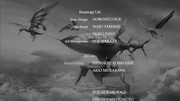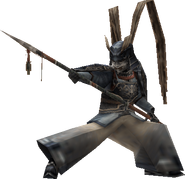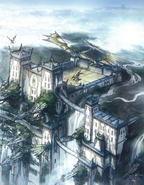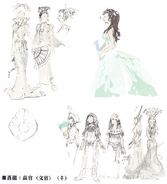Every village in Concordia has lived alongside dragons in prosperity for centuries. Those able to commune with wyverns still reside in each town so as to help maintain our happy coexistence.
Kingdom Citizen in Amiter
The Kingdom of Concordia is a nation that holds the Azure Dragon Crystal in Final Fantasy Type-0. Its capital is Mahamayuri. The kingdom was originally known as the Kingdom of Dracobaltia.
The Concordian people use their Crystal to communicate with dragons and monsters for aid in daily life and to strengthen their military. Concordians are shorter than the denizens of other nations in Orience, never growing beyond 5 feet tall.
Top posts in the Concordia government, save for the King of Concordia, are held by women; Queen Andoria is the only one who can communicate with the Queen Dragon, the physical representation of the Crystal itself. There are five orders of elite knights who protect the Azure Peristylium. One of them is the Akatoki under Celestia, with Yuzuki among its members.
Rubicus[]
- Queen Andoria - Kingdom of Concordia
Home to the Azure Dragon Crystal, the Kingdom of Concordia is a matriarchal nation. From the queen herself down to the lowest-ranking bureaucrats, all important government positions are filled by women. Queen Andoria rules over the land, guarding the Azure Peristylium and sharing the Will of its Crystal with her people.
It is that selfsame Crystal which grants Concordians the ability to communicate with wyverns and other creatures. This power serves the populace well in their daily lives, and military applications of the Azure Dragon's blessing have provided the kingdom with enough power to hold its own against the other three Crystal-States. Given that the Concordians never grow taller than a few feet, they prefer commanding monsters to fight on their behalf. When they are forced to join the fray, however, the kingdom's dracoknights make use of their innate speed to run circles around their enemies, then pierce their foes with long spears.
- Establishment of the Kingdom of Concordia
- Concordia: Institution of Dragon Commands
- The Rubrumite-Concordian War
- The Royal Army
- The Concordian Coup and the Militesi-Concordian Alliance
Story[]
The territory of the Azure Dragon was originally known as Blue Dragon. Contact with the Blue Dragon Crystal and its l'Cie had instilled the ability to command beasts in the otherwise unremarkable people of Rilochy, who became known as Dracobaltians. The kingdom expanded its sphere of influence from Rilochy to Roshana and met with the forces of the neighboring Dominion of Rubrum at the border between Roshana and Eibon Region. The dominion implemented a divide-and-conquer strategy, sending the royal units fleeing, reclaiming its territory. According to legend, the Dracobaltians asked for more power from the Blue Dragon Crystal and gained the ability to command wyverns. Unable to appreciate them as sentient beings, the dragons were slaughtered for food during shortages, and the Blue Dragon Crystal lost power.
Because the male progenitors of the Blue Dragon people had consumed dragons' flesh, the male descendants were cursed to turn into monsters themselves. The female descendants, unaffected by the curse, took over the country in the year 252 under the name Azure Dragon, a new Crystal that had appeared to restore the balance in Orience and replace the Blue Dragon Crystal. Concordia became a matriarchy.
The new Azure Dragon Crystal designated its l'Cie to create the Cursemire of Naraku and seal away the Dracobaltians for eternity, and the Kingdom of Dracobaltia and its Blue Dragon Crystal vanished from Orience. Realizing that the Dracobaltians had failed to develop their Crystal-State due to their lust for power, the Azure Dragon Crystal had its l'Cie establish a country: in the year 271, the l'Cie Cuprine authored the laws of the Azure Dragon and founded the matriarchal Kingdom of Concordia.
To defend the queen, Iunia formed a royal guard with the Five-Star Wardens at its head. Hespera constructed towns and villages that later became the foundation of the present-day Concordia. Finally, the l'Cie Vesta erected a palace in the land of Mahamayuri and declared it the royal capital.[note 1] Once Concordia had laid the foundation of the kingdom, it set out to build up a military. Because the Azure Dragon Crystal had the same power as the Blue Dragon, Concordia formed its armed forces around monsters and wyverns, albeit with a different structure: whereas the Dracobaltian Army had had no clear chain of command, each military unit fighting on its own judgment, the Concordian Army assigned each unit to the command of the leaders of the Five-Star Royal Guard, each of whom answered directly to the queen, and the royal army adopted the use of military ranks common in other nations.
As Concordia solidified its military under the direction of the Five-Star Wardens, tensions with the dominion increased. In 317 Concordia dispatched a small unit to assault a city in the Eibon Region to test the strength of its dragon commands. Rubrum initiated a counteroffensive, and deployed troops from all over the dominion to the Eibon Region. The dominion legions dispatched a force of 40,000 troops to drive out the royal army. The Concordian Army deployed four mixed commands, each containing approximately 100 wyverns. Including reserve soldiers and monsters, the kingdom possessed a fighting force of 30,000. The dominion army suffered casualties in the face of the wyverns' power and, even after calling for reinforcements, barely held their ground. After more than a month of fighting, a succession dispute in Concordia erupted into civil war, and the kingdom's army withdrew.
Steeled through centuries of war, each Crystal-State had developed formidable fighting forces convincing each head-of-state of the possibility of unifying Orience under one banner. The waning of the Crystals' power drove the four state leaders to expedite their war efforts, even if extracting energy from the Crystals exacerbated their deterioration. Fearing the weakening of the Crystals to be permanent, each nation sought to annihilate the others. What became known as the Great Orience War began as a border dispute between the dominion and the Militesi Empire. Concordia launched an assault on Rubrum's rear guard, and the dominion responded by summoning the Verboten Eidolon, Leviathan. As the struggle continued, each nation's Crystal began deteriorating even more rapidly due to the replenishment the weapons, armor, and magic and through the creation of l'Cie. As the power of all four Crystals was waning, on Ventusmens IV in the year 359, the four nations ordered a ceasefire and began preparations for a peace treaty. Pax Codex prohibiting the use of l'Cie in war was drawn up in 361, and in 448 the four peristylia drew up a non-governmental pledge of non-aggression, known as the Fabula Pact.
As Milites annihilates the Lorican Alliance in the year 842 and turns its focus on invading the dominion, the kingdom lends its passive support to Rubrum. Concordia helps the dominion regain the strategically important Togoreth Stronghold, although the fort itself ends up destroyed in a battle between Vermilion Bird and White Tiger l'Cie. Afterward, the royal army proposes a joint offensive against the strategically located North Togoreth town of Mi-Go. The dominion Central Command is tempted, but the commandant is reluctant to reveal the dominion's strategies to the kingdom. Rubrum accepts the proposition with the condition that all legionaries and Agito Cadets participating in the mission refrain from using magic or from performing special squad maneuvers. Thanks to the assistance of its Concordian allies, Rubrum reclaims Mi-Go.

The queen assassinated.
At the behest of the Azure Dragon Crystal, Queen Andoria travels to the imperial capital of Ingram and invokes the Fabula Pact, a peace agreement made between the four peristylia of Orience that grants a short-lived ceasefire before she is assassinated. The King of Concordia, whose title is more of a figurehead, schemed to overthrow the queen and restore the Blue Dragon to power. He assumes control of the nation and allies with the empire to retaliate against the Dominion of Rubrum for their supposed role in Andoria's death. The King of Concordia is frustrated to learn that the Queen Dragon, Soryu, being a l'Cie, obeys only Andoria and will listen to no one now that she is dead. Claes Celestia Misca Sancest, the queen's former aide, succeeds the queen as an Azure Dragon Secundus l'Cie and inherits her Focus.
The king's reign stood on a fragile political foundation, so he hoped the empire's aid would maintain his authority. The queen's assassination left the kingdom in disarray, and the Royal Army's mobilization effort does not proceed as planned. Concordia devises a strategy where the Five-Star Royal Guard would invade the dominion by air. The other units would trek to the border while they organized their ranks, then cross over into dominion territory once the Royal Guard had made their move.

Class Zero fights Shinryu Celestia.
The dominion airship fleet and its Agito Cadets engage the royal army in the First Battle of Judecca. The cadets summon Eidolons to annihilate the Concordian dragons. Soryu, the Azure Dragon Crystal Primus l'Cie, destroys them with her breath until the Vermilion Bird Crystal deploys its own Primus l'Cie, Zhuyu Voghfau Byot, to intercept her and draw her away from the rest of the battle. The fighting continues atop the clouds frozen by Soryu's chilling breath. Rubrum's Eidolons overwhelm Concordia's wyverns, even forcing the Azure Dragon l'Cie Celestia to retreat. The Royal Guard incurs enormous casualties, losing more than 1,000 dragons, making the kingdom unable to continue an invasion of this scope. When the dominion advances toward the royal capital, the kingdom is unable to mobilize enough forces to the defense. To supplement the dwindling royal forces, the king orders the seal on the Cursemire of Naraku broken to unleash the Dracobaltians on the dominion. However, this has virtually no effect on the battle's outcome.
Hearing of the casualties incurred by the Five-Star Royal Guard, Concordia's land units abandon the invasion and revise their strategy. Hoping to exploit the kingdom's loss of momentum, dominion legionaries deployed to the eastern front initiate a land-based offensive to break through the royal defenses and cross into Concordia. A special unit would provide backup by assaulting Kingdom Central Command and keep the royal army occupied while the dominion legions cross the border. Concordia pulls back, giving up all resistance along the border, and the dominion breaches it without suffering more than a handful of casualties.
The King of Concordia goes into hiding, but Class Zero catches him. The elite knight Yuzuki, who had accompanied the king, reveals the extent of the king's plans and the origins of the Dracobaltians before summoning one to eliminate the king once and for all. She presumably meets her demise when she seals Naraku to contain the Dracobaltians within.
Concordia capitulates to Rubrum although some pockets of resistance hold out longer than others. As Rubrum occupies the Militesi capital of Ingram and unites Orience under the banner of the Vermilion Bird Tempus Finis commences and word arrives in Akademeia that Concordia has likely fallen to the Rursus. Celestia arrives in Akademeia offering to help Class Zero get into Pandæmonium, the Land of Judgment that appears at the end of the world. In doing so she defies the Will of the Azure Dragon Crystal and turns into a Cie'th.

Dragons fly alongside a Rubrumite airship in the post-Tempus Finis world.
Locations[]

The kingdom territories are blue on the map of Orience.
Culture[]
Concordians revere dragons as the manifestations of the Azure Dragon Crystal. Though most of Orience speaks one language, Concordians command wyverns in Soryusian. While the common Orience language boasts a superior vocabulary and ease of expression, Soryusian is an intentionally simple language. By limiting the number of phrases, dragoniers and other Concordians can communicate orders to dragons with little room for misunderstandings.
Military[]

Dracoknights.
The Concordian Army comprises of the monarch's Five-Star Royal Guard and the dracoknight forces and the monsters they command. The dracoknight forces are divided into three classes: second and third class are equivalent to privates, while the first class equates to what other nations refer to as "noncoms". The dracoknights are prideful warriors, as even if they can manipulate monsters, they prefer to attack with their own spears. Officers are divided into marshal, general, brigadier, colonel, lieutenant colonel, major, captain, second lieutenant, and officer cadet.
Wyverns comprise the core of the royal army, constituting over 90% of the Concordian forces. The army consists of two types of units: dragon-led mixed commands of monsters and dracoknights, and elite dragon-only commands assigned solely to the Fire-Star Wardens for emergency use.
Wingverns form the core of the royal army, a fixture in every one of the kingdom's dragon platoons. A close relative of the Wingvern, the Skyverns, are deployed with a selected number of regular units: the Kingdom Central Command assigns the majority of them to accompany the Five-Star Royal Guard. Diepverns are high-ranking dragons deployed with a mere handful of units because of their inability to fly, but they compensate for their lack of mobility by controlling the climate summoning downpours and blizzards and heat waves. The Brontovern is its closely related but physiologically superior cousin, and is even rarer, belonging exclusively to the Concordian Royal Guard. The strongest regular dragon in the royal forces is the Flyvern whose riders hold prominent positions in the Concordian military, and thus often serve as or fight directly under royal commanders. Kingdom Central Command deploys an even more deadly breed of Flyvern known as the "Atmosvern" to guard the holy capital city of Mahamayuri.
Regular forces are organized by region. Each varies in scope, but generally a command consists of 100 wyverns, 2000 monsters, and 4000 dracoknights. The kingdom's military includes approximately 100 commands. Because of its numbers mobilizing each command takes time.
The wardens of the Five-Star Royal Guard inherit their positions and play a role in all governmental affairs. Of the Five-Star divisions the house of Akatoki under its Warden Celestia handles all military operations in conflicts against other Crystal-States. Other divisions play unique roles in upholding the kingdom.
l'Cie do not usually partake in military affairs, but the First Battle of Judecca marks a unique turn when two Concordian l'Cie aid the royal army in battle.
List of enemies[]
Musical themes[]
The theme of Concordia is "The Azure Spirit". It also plays in the kingdom's territories on the world map.
Gallery[]
A lot of the artwork is from Final Fantasy Type-0 Kōshiki Settei Shiryōshū Aku no Hishi art book.
Etymology and symbolism[]
Concordia is Latin for "harmony".
The nations of Orience are based on the Four Symbols. The Four Symbols (Chinese: 四象; pinyin: Sì Xiàng) are four mythological creatures in the Chinese constellations. They are the Azure Dragon, (Qing Long) of the East, the Vermilion Bird (Zhu Que) of the South, the White Tiger (Bai Hu) of the West, and the Black Turtle (Xuan Wu) of the North. While originating from China, the Four Symbols are also widely known in Korea, Japan, and Vietnam. Each region have distinct names for the symbols. In Japan, the Shijin, as they are collectively known, are called Seiryū, Suzaku, Byakko, and Genbu respectively.
In the Japanese version, the Azure Dragon uses a less common name for the dragon Soryū (蒼龍?), while the nation of the Blue Dragon it replaced, uses Seiryū (青龍?).
Representing the east of the Four Symbols, Concordia is located on a secluded peninsula eastward from Orience's greater lands. The dragon represents the eastern world, with the tiger representing the western world in Asian cultures. Representing the season of spring, the nation is vibrant with a gentle oceanic climate. Representing the Wu Xing element of Wood, the Azure Dragon Crystal bestows upon its users the Power of the Dragon, allowing them to communicate with beasts, and by extension, nature itself.
Concordia revers dragons with the Queen Dragon being the physical manifestation of the Azure Dragon Crystal itself. In some mythologies, dragons can communicate with sentience. In real life, Asian nations bear the dragon in their heralds and arms to represent great qualities and heavenly providence. The Azure Dragon is revered as benevolent, but can act quickly and forcefully, especially when provoked. Asian dragons are believed to dislike filth, be it from pollution to actions of defilement.
The Azure Dragon Crystal is close in shape to an orb, the choice cut shape for precious jewels in Asian nations, as dragons in Asian mythology bare them in their claws. It represents their closeness to creative powers and universal perfection.

Concordia's symbol in Pandaemonium is the third one from the left.
In Pandaemonium, the symbol for the Kingdom of Concordia is different, being two serpents chasing each other's tails. This is a different interpretation of the Ouroboros symbol, representing cyclicality, however, the representation of two serpents could allude to both Dr. Arecia and Gala attempting to break the cycle in their differing ways.
Notes[]
- ↑ The creation of Concordia's majestic palace was the Focus of Shirotae, a Concordian l'Cie.






























